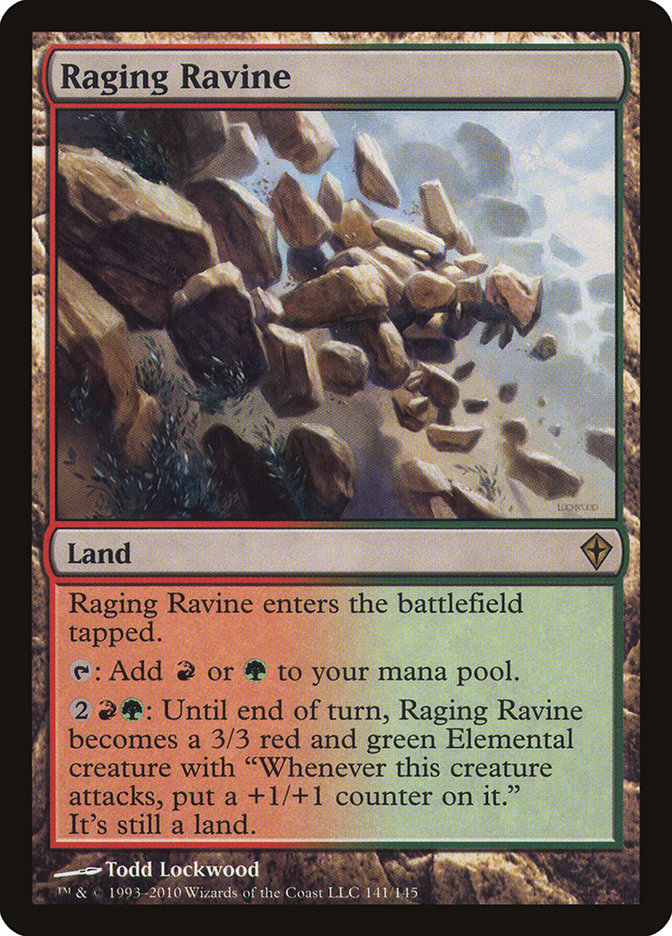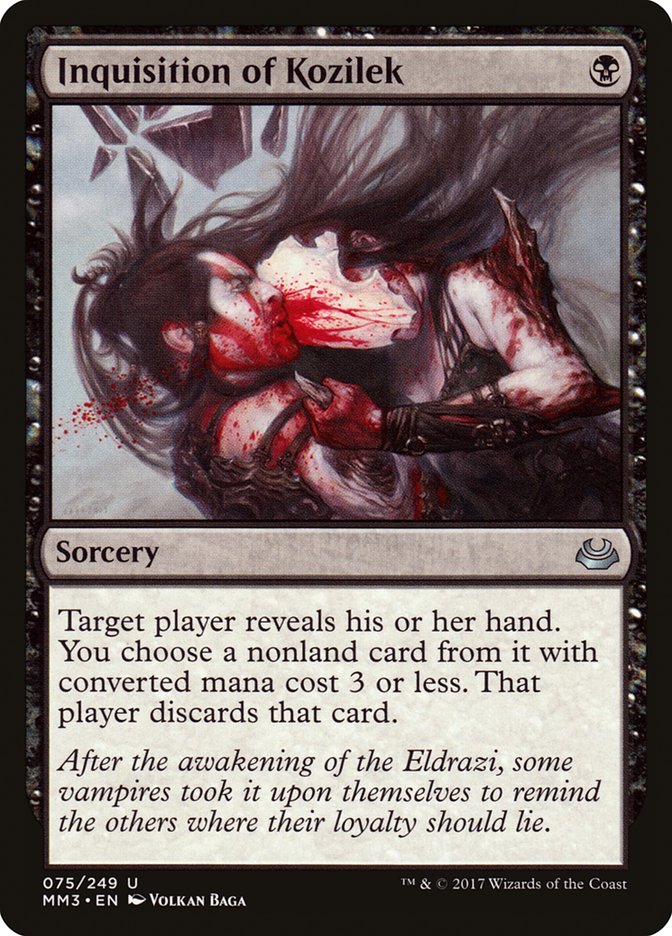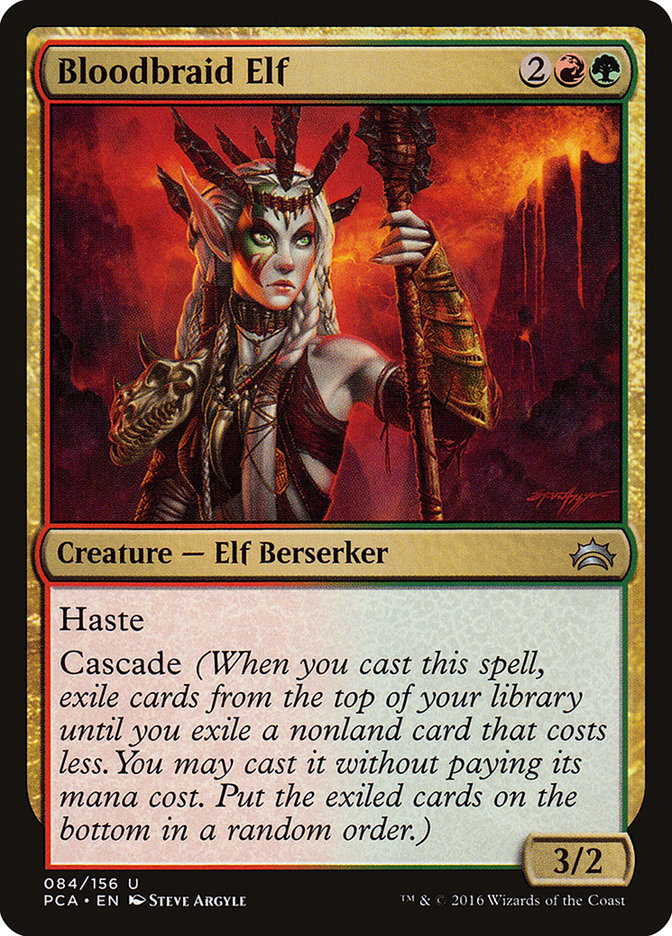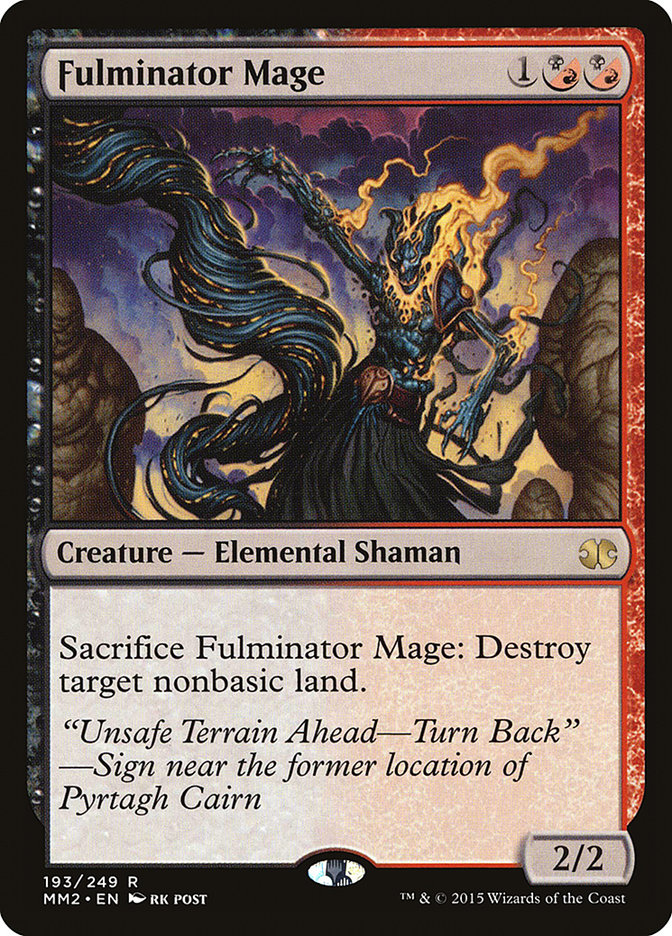So, you’ve decided to play Jund in your next Modern event. Whether that’s
your local FNM or #SCGDFW, you’ve
made a good decision. Congratulations are in order. Maybe you’re a seasoned
Jund veteran, maybe you’ve decided to switch over from less green pastures.
Either way, Bloodbraid Elf and friends won’t steer you wrong.
But listen, I have some bad news: you’re not alone in making this decision.
Don’t worry though, the company you’re keeping is quality. Half of the
Magic Online Championship Series Top 4 last weekend was on Jund, as were a
full seven of the 23 competitors in the tournament. There’s no two ways
about it: If you want to play Jund right now, you must be prepared for the
mirror.
Jund Mirrors 101
Jund mirrors have a little bit of everything. The opening turns are
intensely tactical and the midgame is deeply strategic. You seek to
assemble the more imposing battlefield, but you can’t completely ignore the
life totals. Card advantage is usually the most important thing, but the
right draw can allow you to be successful via adopting an aggressive
stance. It’s midrange gameplay at its finest, with both players having many
decision points each turn and their overall game plan shifting constantly.
It’s truly beautiful Magic.
The criticisms you hear about the Jund mirror generally center on it being
very high variance, that games are often decided by late game topdecks. I
don’t find that to be the case. Historically, my best matchup with Jund has
been Overgrown Tomb mirrors. Back in 2016 I made the top 8 of an SCG Tour
Invitational wielding Jund in the Modern portion, going 5-3 with it in the
Swiss. Not a stellar record, but notable here because of those five wins,
four were B/G/x mirrors. I joked that I should have just played Tron if I
was only ever going to beat Jund and Abzan, but truth be told I would never
give up an opportunity to play more Jund mirrors.
The easiest way to gain equity in Jund mirrors is to understand what’s
important. Big picture, the game is going to last several turns. You’re
going to get the opportunity to cast nearly every spell you draw, most of
which will trade with your opponent’s spells. Your Dark Confidant will
trade with their Lightning Bolt, your Liliana of the Veil will eat their
Tarmogoyf and get attacked down by a Treetop Village, so on and so forth.
Nothing is permanent in the Jund mirror.
Level zero of the Jund mirror is card advantage. You want to line your
spells up with theirs in the most advantageous way possible such that you
are left with a Tarmogoyf or something when the dust settles. You want your
Kolaghan’s Command to be killing an opposing Dark Confidant and regrowing
one of yours while your opponent’s Kolaghan’s Commands are teaming up with
a Lightning Bolt to kill your Scavenging Ooze and making you discard an
excess land.
Knowing that you need to care about having more resources than your
opponent is good, but it doesn’t get you very far. Sure, you know not to
trade a Tarmogoyf off in order to force through five damage and that you
want to hold your Bloodbraid Elf until its cascade trigger is unlikely to
hit a blank. You know that you should kill Dark Confidant instead of
Tarmogoyf if given the choice. Your opponent knows all this too, and
implementing the maxims of card advantage is a relatively easy task.
And so, level one of the Jund mirror is tempo. The Jund deck is filled with
permanents that accrue value over time. Dark Confidant gets you an extra
card every upkeep. Liliana of the Veil can eat another creature every third
turn. Tarmogoyf and Scavenging Ooze can apply their power and toughness to
combat anew every turn. We’ve already covered the fact that all of these
nice cards of ours are going to die, but it turns out that the timing on
their demise is important.
Every extra turn you can manage to keep these cards on the battlefield is a
win for you, whether it’s the obvious win of an extra Dark Confidant flip
or the subtle win of another turn with a Tarmogoyf free of the bonds of
summoning sickness. You can sneak extra turns out of these cards by taking
pains to sequence them in such a way that they line up awkwardly for your
opponent’s removal. Typically, this means double-spelling with them on an
opportune turn.
Liliana of the Veil is my pick for the single most important card in the
Jund mirror. She’s the kind of card that warps how games play out, even
when neither player actually draws her. On the card advantage level, she’s
a powerhouse. But she’s so much more than just a card advantage generator.
If Serum Visions and Brainstorm are cards that let you sculpt a gameplan,
Liliana is a card that lets you chisel one. Instead of selecting cards you
do want, you’re discarding ones you don’t want. If you don’t have a good
idea of how you want the game to play out, you’re going to discard the
wrong cards. She’s obviously better for her controller, but the decisions
presented by discarding tend to favor the more skilled player.
In the Jund mirror, the most important mode on Liliana is the minus two.
There’s not a lot you can do to stop Liliana from eating one of your
creatures. You can work to insulate from the edict with multiple creatures,
but the reality is that you’re going to lose something. The real killer is
losing two creatures to her, and you need to do whatever it takes to make
that not happen.
The flip side here is obvious: when it’s your Liliana, you want to keep her
alive as long as possible. The key to this is to value her loyalty
appropriately. When people start to describe game states to me, they’ll
often just say “so I had a Liliana” and leave her loyalty out of it. Her
loyalty is a very important part of the game state, and you should treat it
as such.
A Liliana on four is a lot scarier than a Liliana on one. When you get to
play Liliana onto an empty battlefield and tick her up with no
creature-lands in sight, you feel very far ahead. If they play two
creatures out, you can minus two Liliana and have all of your mana
available to defend her from the other creature. The only clean way out for
your opponent is Abrupt Decay, and that’s not a great spot to be in. When
possible, engineer scenarios where you can tick Liliana up immediately, not
down.
Dark Confidant is the easiest way to generate raw cards in the entire Jund
deck. It’s also the most fragile non-land permanent in the entire deck,
which isn’t a great place to be when you’re also the highest priority
target for removal. There’s nothing your opponent would rather kill, and
there’s no removal spell they play that can’t kill Dark Confidant. It’s
hard to get a Confidant to stick.
Hard, but not impossible. There’s two excellent times to play Dark
Confidant. The first is exactly on turn 2, in the hopes that your opponent
is lacking a one or two mana removal spell and you’ll just get to mise a
free card. The second is as late as possible, after every other creature in
your hand in the hopes that you will run your opponent out of removal and
your Dark Confidant will go uncontested. On balance, I prefer the second
timing.
You can use the fragility and importance of Dark Confidant to your
advantage. Because your opponent has to kill it if at all
possible, you can contort their play in profitable ways if you carefully
choose when to deploy your Dark Confidant. For instance, suppose you run
out your Dark Confidant while their tapped out right before their fourth
turn. Now if they make the most powerful play they have access to, casting
Bloodbraid Elf, they run the risk of letting you untap with Dark Confidant.
They will likely choose to remove your Dark Confidant instead, delaying
their Bloodbraid Elf turn. This is a win for you.
I chose to put Raging Ravine here as it is the land that is the most
influential on how individual games of the mirror play out, but the point I
want to make would be most emphasized if I had used a picture of a Swamp
instead. In the Jund mirror, lands are your friends. No, they don’t give
you card advantage. To the contrary, at their worst extra lands are
essentially a form of card disadvantage. That’s okay though, because the
large and immensely valuable tempo advantage your fifth and sixth lands
give you is worth that risk.
Having ample lands is what gives you control over how you play the game
out. When you’re stuck on two lands, it’s nearly impossible to justify not
running out one of your two-drops every turn. When you have four lands, you
can comfortably just leave removal up because you know you’ll be able to
double spell later and catch up on tempo if necessary. This freedom is what
lets you line your cards up to your best advantage.
Further, hitting lands four and five also lets you get the most cards out
of your hand before an active Liliana of the Veil forces both players into
being hellbent. This is a form of card advantage, as you would otherwise
lose those cards to Liliana’s +1. When your hand is heavy on threes and
fours, especially if it has Kolaghan’s Command, this can be exceptionally
important.
Alright, I know what you’re probably thinking: it’s good to know that lands
are important, but what can I really do with this information besides not
mulligan five-landers?
One of the biggest mistakes I see people make in Jund mirrors is to discard
lands they shouldn’t to Liliana of the Veil. It seems to be an automatic
response for most people: if I have enough lands to cast all my spells, I
should discard any extras to Liliana. You shouldn’t think like this. Sure,
sometimes discarding lands to Liliana is right. But often it’s the worst
possible discard in your hand, and it’s certainly not a decision you should
be making on autopilot.
Let’s Talk About Those Discard Spells
Thoughtseize and Inquisition of Kozilek are the hallmark cards of the Jund
deck. They are your best spells against decks that aren’t playing fair.
Often, they’re regarded as the best cards in the deck, full stop.
They’re not very good in the mirror.
This is common wisdom at this point. Generally, the reason given for this
fact is that you want all of your cards in Jund mirrors to be good off the
top of the deck. The game is going to reach a point where both players have
no cards in hand, and you want every card you draw at that point to do
something. This is true, and very important, but it’s not the whole story.
Most of the cards in the Jund deck are virtually the same. Sure, Fatal Push
and Terminate are technically different cards. So are Tarmogoyf and
Scavenging Ooze, but just like Fatal Push and Terminate, they do basically
the same thing. Discard is at its weakest when the cards are all the same
and none of them are unbeatable.
There are a few cards that are better than the others. Liliana of the Veil
is a very frequent selection for the discard spells, as is Kolaghan’s
Command. These cards virtually always provide raw card advantage, so you do
accomplish something real when you get one of them out of your opponent’s
hand. There just aren’t enough of these cards to be worth the risk of
drawing discard spells when your opponent is empty handed.
Bloodbraid Elf changed the discard spell paradigm, but it did so in an
interesting way, as Bloodbraid pulls in both directions. On one side,
having discard spells in your deck to cascade into with Bloodbraid Elf is
quite bad, as they will often be dead and are generally a terrible cascade
hit. On the other side, Bloodbraid Elf is another card that is truly a cut
above the rest of the deck and gives you another reason to actively want to
be Thoughtseizing.
All in all, I still don’t want discard spells in my deck after sideboard.
Case closed.
Well, not really. Here’s the thing: we live in the real world, and in the
real world we only get fifteen cards in our sideboard. Modern is the most
diverse format Magic has ever seen, so it’s hard to justify using six of
your fifteen board slots on cards for the mirror match. So the real
question we need to be asking isn’t “are discard spells bad?” but rather
“are the discard spells worse than our sideboard options?”
If you could start every game of the mirror with Thoughtseize in your hand
and never draw a copy after the opening hand, you would absolutely do that.
The knowledge of their starting hand is very valuable, and the potential of
snagging their only removal spell so that you can stick a Dark Confidant is
a very real thing. The discard spells are bad on balance but do come with a
potentially high upside.
In the end, for most Jund configurations it ends up coming down to whether
you’d rather play with Fulminator Mage or Thoughtseize after sideboard.
Pre-Bloodbraid Elf, I liked Fulminator Mage. Now, I think I like the first
two Thoughtseizes. Nabbing a Bloodbraid Elf out of their hand is just too
much of a swing in equity to be ignored. I don’t want to go past two
discard spells in my deck, but I don’t find the first two completely
abhorrent. Note that Thoughtseize is preferred over Inquisition due to
being able to take Bloodbraid Elf.
And if you come up with a way to have a flexible sideboard that covers all
the ground you need to cover and has tons of great cards for the mirror,
get those Thoughtseizes out of there.
The Importance of Life Totals
Jund mirrors favor the aggressor. You can’t give up actual cards in order
to force through damage, but when you are able to adopt an aggressive
posture, things tend to go well for you. There’s a reason no one ever
chooses to draw in the Jund mirror, despite it nominally being all about
card advantage. You want to be attacking.
One of the big strengths of Jund is its ability to turn the corner quickly.
In mirrors, it’s common to see a single removal spell on a critical
opposing Tarmogoyf instantly sink the sails of the defensive force and
enable a huge attack for a large chunk of life. This means that if you let
your life total fall too low, you might just die out of nowhere.
As with everything else in Jund mirrors, in the end it comes down to card
advantage. The life totals are a means to an end. If you can get your
opponent’s life total low enough, you turn attacks with your Tarmogoyf into
a removal spell. It’s a way to turn a tempo advantage into card advantage
into some match points.
Aggression is also important because it’s the only way to steal games when
your opponent’s draw is much better than yours. In half the games of the
mirror you play, your opponent will draw better than you. In maybe half
again of those games, your opponent will draw so much better than you that
you won’t be able to fight them on the card advantage axis. In those games,
you have to make their life total matter.
In practical terms, what this means is that you should be valuing the life
totals appropriately. If two plays are close, make the one that doesn’t
make you fetch up a shock land. If you have an opportunity to get an attack
with a creature land in, do that instead of leaving up reactive mana or
minorly developing your battlefield. Understand that you can’t afford to
make plays with low battlefield impact like Kolaghan’s Command in discard /
regrowth mode when your opponent is getting profitable attacks through.
A Controversial Ending
I’ve started to get some serious Magic Online grinding with Bloodbraid Jund
under my belt, and I’ve come to a conclusion that startled me: the time has
come to sideboard out some number of Dark Confidants in the mirror.
I know, I know. It sounds completely wrong. Hear me out.
On the draw, having your turn 2 Dark Confidant be killed by their turn 3
Liliana, the Last Hope is a nightmare. Barring the rest of their draw being
miserable, this game is close to unwinnable. The fact that their Liliana
killed your creature and increased its loyalty is a huge beating.
You’re going to have to do a lot of work to get rid of that Liliana, and
you’re already down a card. If you happen to have a second Dark Confidant
in your hand, you won’t be able to cast it for a very long time. It’s a
miserable feeling. Trust me.
This has been a potential play pattern ever since the printing of Liliana,
The Last Hope. It became relevant now with the unbanning of Bloodbraid Elf
because Liliana, The Last Hope is such a stellar cascade hit off of
Bloodbraid Elf. I fully expect most of my opponents in the Jund mirror to
have two copies of Liliana, The Last Hope in their deck after sideboard,
and I want to avoid the above sequence at all costs.
The other thing Bloodbraid Elf has done is move Jund lists away from Fatal
Push and towards Lightning Bolt. Bolt is actually not that great in the
Jund mirror, especially in the early game. There’s essentially no cards in
the deck that it can reliably trade with, with one exception: Dark
Confidant. If you don’t deploy a Dark Confidant, you can turn their
Lightning Bolts into dead cards, and that’s very valuable.
Okay, all that being said, don’t go overboard. Dark Confidant is still one
of your very best cards in the matchup. At most, you should be sideboarding
out one or two copies. We really just want to accomplish the goal of not
drawing two copies, as that’s what can force us into playing one out too
early into a potential Liliana, The Last Hope or Lightning Bolt.
It’s even possible you only want to sideboard out Confidant on the draw.
That’s the approach Steve Rubin took in his Magic Online Championship
semi-final Jund mirror last weekend, sideboarding out exactly one Confidant
every game he was on the draw. Confidant interactions line up much worse on
the draw, as you don’t even get a single upkeep before Liliana, the Last
Hope or Kolaghan’s Command can take him out.
It’s a weird world out there. One year ago, I would have never thought I
would be floating the idea that the fourth Dark Confidant was worse than
the first Thoughtseize in the Jund mirror. I would have laughed at you for
suggesting it.
Welcome to Jund in 2018, I guess.











